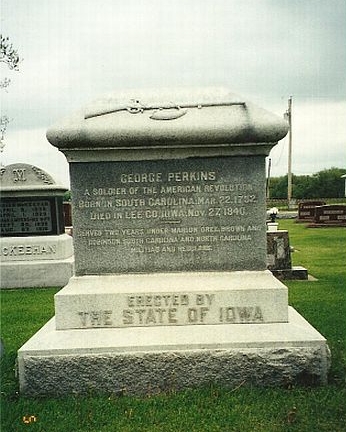There are seven
Revolutionary War soldiers buried in Lee County. All of
them were born in the mid-1700s but since this area west of the
Mississippi did not open for settlement until 1833, most Revolutionary
War veterans were gone and the ones who came were old men who did not
live long. They are as follows:
Ebenezer Ayres
Timothy Brees: Born in 1761 in New Jersey and served for that state as
a private in the 1st New Jersey Regiment. He died in 1847 and is buried
at Lost Creek Cemetery.
Abram Clark: Born 1766, North Carolina, died ca 1850 in Pleasant Ridge
Township, Lee County. He is buried in Woolens Cemetery, north of West
Point on Lowell Road. He was in Captain Shepard’s Company of the North
Carolina 10th Regiment.
Amos Glover: Born in 1758 in Delaware, served as a drummer boy for
Delaware. He died in 1843 and is buried in Croton Cemetery.
Cato Mead: Black, born in 1762 in Connecticut and died in 1846 near
Montrose. He served in the 5th Connecticut Regiment and is buried in
Montrose Cemetery.
Joseph Patterson: Born in 1766 in Virginia and served in the 7th and
8th Virginia Regiments. He died at Keokuk in 1850 and is buried in
Oakland Cemetery.
George Perkins: Born March 22, 1752 in the Blue Ridge
Mountains of South Carolina, served with Francis
Marion in North and South Carolina, died in 1840 near Primrose in Lee
County and buried in Sharon Cemetery.
Gravestone image below states: A Soldier of the American Revolusion

Because they were old men by the time this area was open
for settlement, very few came and those who did had only a few years
left. There are not many complete records for George. We know he
served nine times between May 1776 and May 1780, or about two years
total. It was customary to enlist for single forays or whenever the
enemy came too close. He served for both North and South Carolina under
Francis Marion, “the Swamp Fox,” as well as other generals.
Strong and sturdy in both mind and body, but unlearned in letters, he
lived the simple life. His maintenance was from what he slew in the
forest and cultivated in the clearings. He wore garments made from
deerskin,
dressed and cured with his own hands and cloth carded, spun and woven.
He made hats, gloves and garments from the animals he trapped. He built
his own still
and made whiskey from the corn he raised and he smoked the tobacco he
grew. According to a story written by his grandson James Cruickshank,
he did
not belong to any special church but he believed in God and “always
kept his powder dry.”
In 1779 in North Caroline, he married Keziah Manning. They raised a son
Stephan and a daughter Anna from which came a line of over 500
descendents. Stephan had a large family and his daughter Keziah married
Alexander Cruickshank. Anna, who married a man named Graves, was
widowed young.
While living in Kentucky, George applied for a war pension but only
received it for six years.
Anna, her son and George and Keziah came to a farm close to Primrose in
1837. George and Keziah did not live long - George dying in 1840 and
Keziah in 1849. They were buried in a little country graveyard near
their home and there they slept for over 65 years. In 1906, the
DAR at Keokuk petitioned the State of Iowa for a stone to be placed in
the Sharon Cemetery and in a story dated September 2006 there appeared
an article in the old Keokuk newspaper stating “the remains of George
Perkins have been removed.” It tells of a few relatives being summoned
to the old McGreer Cemetery (also known as McKeehan and Old Howard
Burying Ground) when the graves were opened and all that was found were
a few bones, a hank of red hair, a few nails and pieces of wood. Along
with some of the surrounding soil, all were placed in a small box and
taken to the new grave site.
Dedication of the monument May 28, 1907, was a great day in Sharon
Church history. Horses were tied to the hitching posts all along the
east and north sides of the cemetery which was lined with buggies and
wagons. Several hundred people attended. The service opened with
prayer, patriotic addresses by descendents and other prominent people,
the unveiling of the monument, and patriotic songs. And best of all,
there was dinner on the ground.
The Monument Carved from the finest marble from the quarry of Barre,
Vermont, it was an impressive stone and Iowa did herself proud. Costing
$500, George would never have been able to realize all of this. The
stone stands six feet high and a flintlock rifle and powder horn are
carved into the massive top piece. The middle piece tells his birth
date, death date, years of service, and the officers he served under.
“Erected by the State of Iowa” is carved across the bottom. George and
Keziah rest in a beautiful historic place. “His bones are dust, his
flintlock rust. His soul is with the Saints, we trust.” ~ Unknown
Sources for this article include old Keokuk newspapers, a story written
by James Cruickshank, program on the dedication and information from
the Perkins folder located in the Genealogy Department of the
Donnellson Library. Photo taken by Diane Kruse at the Sharon Cemetery.
Researched and submitted by Erma Derosear
|
|



